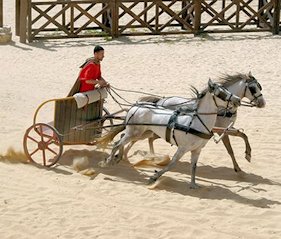
|
Some Common Myths Thought to be True - Myth 125
Myth 125: The Romans Used Chariots to Win Battles
All-chariot battles played out a little differently. It seems most
likely that opposing chariot armies would line up in single or double lines.
The reason for such shallow formations is to prevent the collisions between
downed chariots and those coming up from behind. If a chariot army consisted
of thousands of chariots these lines would be truly enormous. On a relief
depicting the Battle of Kadesh, Pharaoh Rameses the Great claims have lined his
chariots in formation over a mile long. The opposing lines of chariots would
then charge each other firing arrows at the enemy's chariot horses. As the
lines approached each half of the army would turn towards the outside in a
U-turn while continuing to shoot volleys at the enemy army.
|
| Roman Chariot | |
|
The armies would
continue this charge and retreat tactic until one of the armies broke and ran.
Despite popular depictions chariot armies did not weave through each other and
then turn and charge. The two armies would most likely have rammed each other
head on and destroyed huge numbers of chariot and lives in the process. If
this were attempted both armies would be destroyed after just a few charges.
As chariotry warfare was played out on the plains there was little chance of
one army moving undetected and flanking the enemy army. In fact with one
exception, the infantry that was used at this time was used solely to prevent
such tactics.
|
|
| ⇦ Back to Myth 124 Return to Myth Choices Page 9 On to Myth 126 ⇨ | |